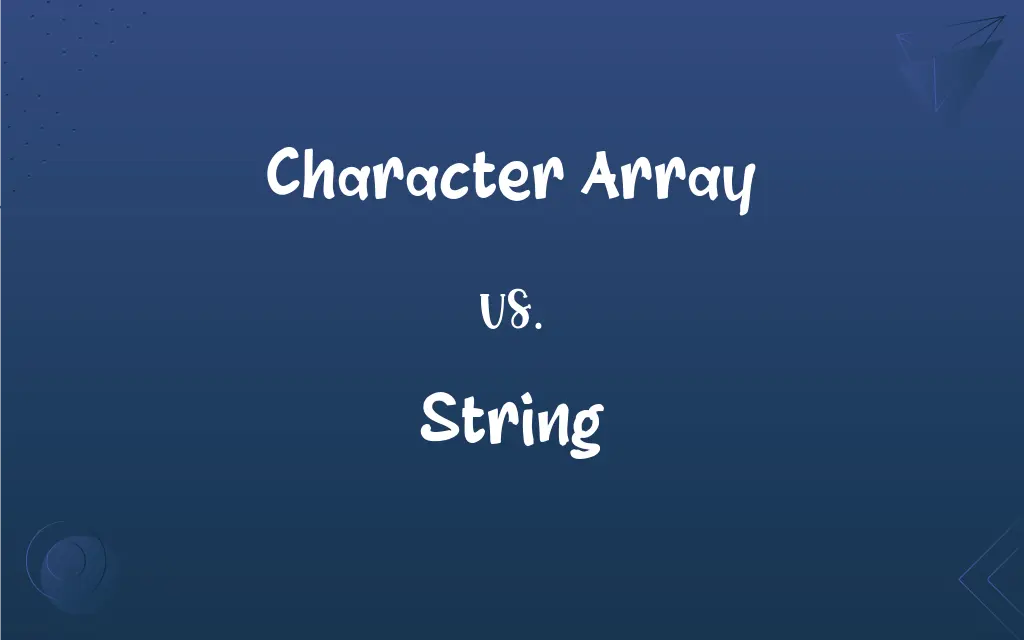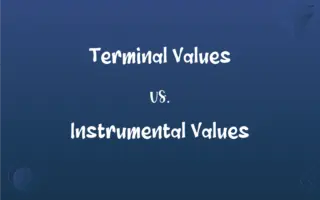Character Array vs. String: What's the Difference?
Edited by Aimie Carlson || By Janet White || Published on March 5, 2024
A character array is a sequence of characters, managed as individual elements, whereas a string is a single object representing text as a contiguous sequence.

Key Differences
A character array is a collection of characters stored in contiguous memory locations, accessible individually by indexing. Each character can be manipulated separately. In contrast, a string is a single object that represents text as a whole. While a string can be thought of as an array of characters, it is treated as a single entity, often with built-in methods for manipulation.
In many programming languages, a character array requires manual management of its size and can be modified in place, allowing individual elements to be changed easily. Strings, however, are often immutable, meaning once created, they cannot be altered without creating a new string. This distinction highlights the mutable nature of character arrays versus the fixed nature of strings.
Character arrays can be more efficient in scenarios requiring intensive manipulation of individual characters, as they allow direct access to each character. Strings offer convenience and are more intuitive for representing textual data, with functionalities like concatenation and substring extraction readily available without manual manipulation of characters.
Memory allocation differs between the two: a character array must be allocated with enough space to hold all its characters, including a null character if it’s null-terminated. A string, especially in high-level languages, abstracts away memory management, dynamically allocating space as needed.
When dealing with low-level operations, such as interacting with certain system APIs, character arrays may be preferred for their precise control over memory layout. Strings, on the other hand, are ideal for general text processing and manipulation in high-level programming due to their ease of use and array of built-in methods.
ADVERTISEMENT
Comparison Chart
Nature
Mutable, individual characters are modifiable
Often immutable, treated as a single entity
Memory Management
Manual size management, including null termination for C-style strings
Automatic management, dynamic allocation
Access
Direct access to individual characters
Access through string methods
Use Case
Efficient for character-level manipulation
Convenient for general text processing
Examples in Languages
Char[] in C and C++
String class in Java and Python
ADVERTISEMENT
Manipulation
Requires manual manipulation for operations like concatenation
Built-in methods for operations like concatenation, search
Character Array and String Definitions
Character Array
Character arrays are used where direct memory access to text is needed.
Char userId[6] = {'u', 's', 'e', 'r', '1', '\0'};
String
A string is a sequence of characters treated as a single object.
String name = Alice;
Character Array
It's a low-level representation of strings, especially in system programming.
Char errorMessage[] = Error occurred;
String
It represents text and offers methods for manipulation and retrieval.
String greeting = Hello, World!;
Character Array
It's an array where each element is a character, often used in C and C++.
Char letters[5] = {'a', 'b', 'c', 'd', '\0'};
String
Strings are often immutable, creating a new string for each modification.
String fullName = firstName + + lastName;
Character Array
Character arrays allow individual character manipulation in memory.
Char buffer[10]; buffer[0] = 'H';
String
A string is a high-level construct for text management in programming.
String formattedDate = formatDate(date);
Character Array
A character array is a sequence of characters stored in contiguous memory.
Char name[] = {'J', 'o', 'h', 'n', '\0'};
String
Used for text processing, strings abstract away from character-level details.
String encrypted = encrypt(password);
String
(Computers) A set of consecutive characters.
FAQs
Are strings mutable?
Strings are often immutable, creating new strings for modifications.
What is a string?
A single object representing text as a contiguous sequence.
How is memory managed for character arrays?
Memory must be manually allocated and managed, including null termination in some languages.
What are character arrays used for?
Used for low-level text manipulation and in system programming.
Can you modify individual characters in a string?
In many languages, strings do not allow direct modification of individual characters.
What is a character array?
A sequence of characters stored in contiguous memory, accessible individually.
Do character arrays have built-in methods?
Typically, they don't have built-in methods and require manual manipulation.
Do strings offer built-in methods for text manipulation?
Yes, strings provide various built-in methods for ease of use.
How do you initialize a character array?
By directly assigning characters to array elements or using a string literal in some languages.
Is it easier to manipulate strings than character arrays?
Generally, yes, due to higher-level abstractions and built-in methods.
Can strings be used in low-level programming?
Strings are less common in low-level programming due to their abstraction and overhead.
How are strings used in programming?
Ideal for high-level text processing and manipulation.
Are strings suitable for all text manipulation tasks?
While versatile, strings may not be the best choice for extremely memory-sensitive or low-level tasks.
Can character arrays be automatically resized?
Character arrays do not resize automatically; they have a fixed size defined at initialization.
Can strings handle dynamic text sizes?
Yes, strings handle dynamic text sizes automatically in many languages.
How do character arrays handle Unicode characters?
Handling Unicode can be more complex and requires larger character types or special encoding.
Are character arrays more efficient than strings?
They can be more efficient for specific, low-level operations.
Do strings require manual memory management?
In high-level languages, strings typically do not require manual memory management.
Why choose a character array over a string?
For precise control and efficiency in character-level operations.
Can you concatenate character arrays easily?
Concatenation requires manual operation in character arrays.
About Author
Written by
Janet WhiteJanet White has been an esteemed writer and blogger for Difference Wiki. Holding a Master's degree in Science and Medical Journalism from the prestigious Boston University, she has consistently demonstrated her expertise and passion for her field. When she's not immersed in her work, Janet relishes her time exercising, delving into a good book, and cherishing moments with friends and family.
Edited by
Aimie CarlsonAimie Carlson, holding a master's degree in English literature, is a fervent English language enthusiast. She lends her writing talents to Difference Wiki, a prominent website that specializes in comparisons, offering readers insightful analyses that both captivate and inform.































































